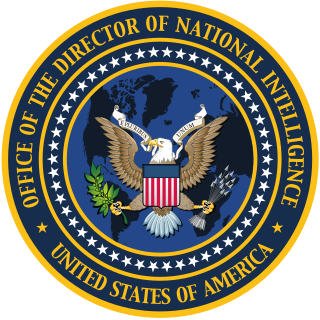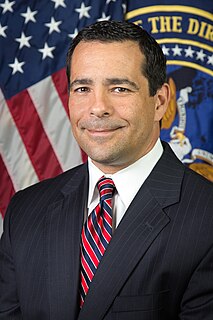
The National Geospatial-Intelligence Agency (NGA) is a combat support agency within the United States Department of Defense whose primary mission is collecting, analyzing, and distributing geospatial intelligence (GEOINT) in support of national security. Initially known as the National Imagery and Mapping Agency (NIMA) from 1996 to 2003, it is a member of the United States Intelligence Community.

The Director of National Intelligence (DNI) is a senior, cabinet-level United States government official, required by the Intelligence Reform and Terrorism Prevention Act of 2004 to serve as executive head of the United States Intelligence Community (IC) and to direct and oversee the National Intelligence Program (NIP). All IC agencies report directly to the DNI. The DNI also serves, upon invitation, as an advisor to the President of the United States, the National Security Council and the Homeland Security Council on all intelligence matters. The DNI, supported by the Office of the Director of National Intelligence (ODNI), produces the President's Daily Brief (PDB), a top-secret document including intelligence from all IC agencies, handed each morning to the President of the United States.

The United States Intelligence Community (IC) is a group of separate United States government intelligence agencies and subordinate organizations that work both separately and collectively to conduct intelligence activities which support the foreign policy and national security of the United States. Member organizations of the IC include intelligence agencies, military intelligence, and civilian intelligence and analysis offices within federal executive departments.
A special agent is an investigator or detective for a governmental or independent agency, who primarily serves in criminal investigatory positions. Additionally, many federal and state special agents operate in "criminal intelligence" based roles as well. Within the U.S. federal law enforcement system, dozens of federal agencies employ federal law enforcement officers, each with different criteria pertaining to the use of the titles Special Agent and Agent.

The Foreign Intelligence Service of the Russian Federation or SVR RF is Russia's external intelligence agency, focusing mainly on civilian affairs. The SVR RF succeeded the First Chief Directorate (PGU) of the KGB in December 1991. The SVR has its headquarters in the Yasenevo District of Moscow.

The United States Naval Criminal Investigative Service (NCIS) is the primary law enforcement agency of the U.S. Department of the Navy. Its primary function is to investigate criminal activities involving the U.S. Navy and U.S. Marine Corps, though its broad mandate includes national security, counterintelligence, counter-terrorism, cyber warfare, and the protection of U.S. naval assets worldwide. NCIS is the successor organization to the former Naval Investigative Service (NIS), which was established by the Office of Naval Intelligence after the Second World War.
The National Intelligence Board (NIB), formerly the National Foreign Intelligence Board and before that the United States Intelligence Board is a body of senior U.S. Intelligence Community leaders currently led by the Director of National Intelligence (DNI). The Board is tasked with reviewing and approving National Intelligence Estimates (NIEs).
The timeline of the Cox Report controversy is a chronology of information relating to the People's Republic of China's (PRC) nuclear espionage against the United States detailed in the Congressional Cox Report. The timeline also includes documented information relating to relevant investigations and reactions by the White House, the U.S. Congress, the Federal Bureau of Investigation (FBI), and United States Department of Justice.

The under secretary of defense for intelligence and security or USD(I&S) is a high-ranking civilian position in the Office of the Secretary of Defense (OSD) within the U.S. Department of Defense (DoD) that acts as the principal civilian advisor and deputy to the secretary of defense (SecDef) and deputy secretary of defense (DepSecDef) on matters relating to military intelligence and security. The under secretary is appointed as a civilian by the president and confirmed by the Senate to serve at the pleasure of the president.
National intelligence programs, and, by extension, the overall defenses of nations, are vulnerable to attack. It is the role of intelligence cycle security to protect the process embodied in the intelligence cycle, and that which it defends. A number of disciplines go into protecting the intelligence cycle. One of the challenges is there are a wide range of potential threats, so threat assessment, if complete, is a complex task. Governments try to protect three things:

The Office of Intelligence and Analysis (I&A) is an intelligence element within the Department of Homeland Security (DHS) and one of the members that comprise the United States Intelligence Community (IC). I&A is led by the Under Secretary for Intelligence and Analysis, a senate-confirmed position that also serves as the Chief Intelligence Officer for DHS.
The federal government of the United States empowers a wide range of law enforcement agencies to maintain law and public order related to matters affecting the country as a whole.
The National Intelligence Strategy of the United States of America (NIS) is a product of the Office of the Director of National Intelligence (DNI). Drafted and implemented in 2005 while John Negroponte served as the DNI, it describes the drastic overhaul the United States (US) intelligence community will carry out. According to this strategy, the US intelligence community will create a new system for sharing information, while integrating its existing enterprises to meet its mission objectives and enterprise objectives. The changes to the intelligence community, including changes in tasking, derive from the 2002 US National Security Strategy. The legal basis for the new strategy is derived from the Intelligence Reform and Terrorism Prevention Act of 2004.
United States Intelligence Community Oversight duties are shared by both the executive and legislative branches of the government. Oversight, in this case, is the supervision of intelligence agencies, and making them accountable for their actions. Generally oversight bodies look at the following general issues: following policymaker needs, the quality of analysis, operations, and legality of actions.

The CIA publishes organizational charts of its agency. Here are a few examples.
The National Nuclear Security Administration (NNSA) is a United States federal agency responsible for safeguarding national security through the military application of nuclear science. NNSA maintains and enhances the safety, security, and effectiveness of the U.S. nuclear weapons stockpile; works to reduce the global danger from weapons of mass destruction; provides the United States Navy with safe and effective nuclear propulsion; and responds to nuclear and radiological emergencies in the United States and abroad.

Robert Cardillo is a Distinguished Fellow at Georgetown University’s Center for Security and Emerging Technology. Prior to this appointment, he was the sixth Director of the National Geospatial-Intelligence Agency and was sworn in October 3, 2014. He was previously selected by Director of National Intelligence James Clapper to serve as the first Deputy Director of National Intelligence for Intelligence Integration in September 2010. Clapper said in a statement that the position would "elevate information sharing and collaboration" between those who collect intelligence and those who analyze it. Cardillo previously served as Deputy Director of the Defense Intelligence Agency (DIA). Prior to that, he served as the Deputy Director for Analysis, DIA, and Director, Analysis and Production, National Geospatial-Intelligence Agency (NGA).

William R. Evanina is an American national security official who served as director of the United States National Counterintelligence and Security Center (NCSC) until his January 2021 resignation. As director of the NCSC he was the head of national counterintelligence for the U.S. Government. Evanina previously served as director of the Office of the national counterintelligence executive (ONCIX) before it transitioned into the NCSC. Prior to his service as national counterintelligence executive, he was the chief of the Counterespionage Group for the Central Intelligence Agency. He gained his initial law enforcement experience as a special agent for the Federal Bureau of Investigation.

Stacey Angela Dixon is an American intelligence official and Principal Deputy Director of National Intelligence in the Biden Administration since August 4, 2021.













